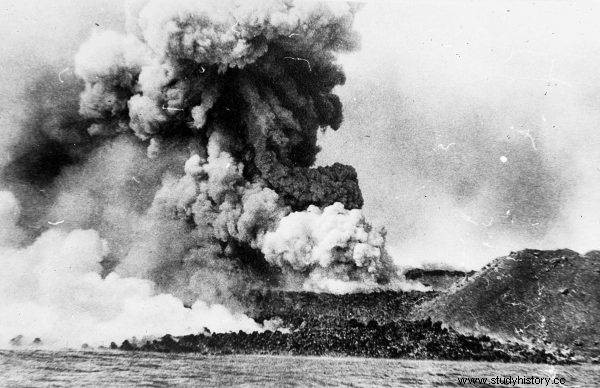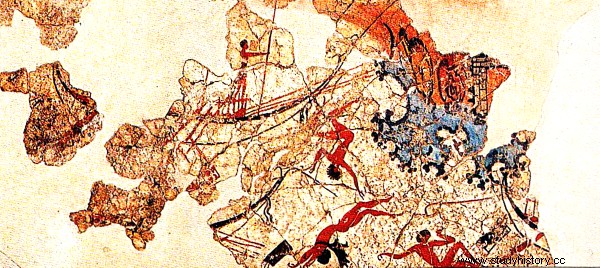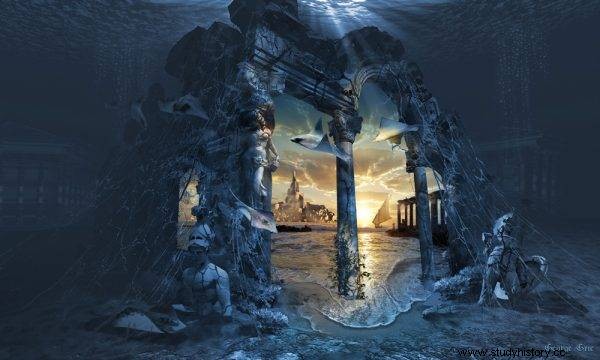Was the mythical Atlantis not far from the ancient world, but in its center? I am talking about the island of Santorini in the Mediterranean Sea.
1000 years before the golden age of ancient Greece, the Minoan culture was thriving in Santorini. Today, the slogan that perhaps Atlantis was located here is eagerly used by hotels and travel agencies. However, it is true that the Minoan world collapsed suddenly and violently under the influence of natural forces. So does the Atlanteans civilization.
On the trail of the secrets of ancient civilizations
Today, scientists studying cultures from before the millennia more and more often combine advanced technology and methods in the field of science with historical and archaeological knowledge and methodology. They can provide amazing examples of ancient civilizations that lived in harmony with their natural surroundings and at the same time used 100% of the potential of nature. One of them is the Mohenjo Daro culture in the Indus Valley. More than 5,000 years ago, people built well-planned cities there - with smooth streets, running water in houses and sewage systems . They also created advanced engineering devices. Thanks to the system of large reservoirs, they used clean water all year round. A network of irrigation canals irrigated the surrounding gardens, orchards, and fields, producing bountiful crops. They were self-sufficient and lived in well-being. 
At the other extreme, we have ancient poisoners. The Romans loved lead. They used it on a daily basis for the production of cosmetics, dishes and water supply. This toxic passion has had an impact on the environment. In 2015, scientists from the United Kingdom, the United States and France examined sediments from the bottom of Trajan's Bay in Portus, 30 km from Rome. The result was shocking. The water from the heyday of the imperial capital was heavily poisoned. The concentration of lead turned out to be even a hundred times higher than in the surrounding sources.
However, the devastating effects of the abuse of lead extended much further. Scientists who analyzed samples of deep ice from the Arctic measured the content of this element in them. The samples corresponded to the period from 1100 B.C.E. up to 800 AD Research has shown that lead levels rose sharply during the empire's heyday. The impact of the climate on the history of ancient cultures is dedicated to the documentary "Tajemnice former civilizations", which will be broadcast on the Polsat Viasat History channel this Friday - 10.06. at 9.00 p.m.
Wrath of the gods
The impact of climate change on civilizations is, of course, also powerful catastrophes that have been able to reverse the course of history . Eruption of Vesuvius in 79 CE he destroyed Pompeii. It is one of the best-known examples of the devastating effects of an eruption from the depths of the earth. However, not the most spectacular at all. More than 1,500 years earlier, another catastrophe wiped out the ancient Minoan culture and left its mark on the entire Mediterranean.
The Minoans created great urban centers in Crete, such as the royal Knossos and Phaistos. They traded with mainland Greece, Egypt and other countries. They left behind a rich art. They used two types of writing. The Minoan culture is also associated with stories that have become a permanent part of the canon of European culture. It was here that King Midas was to rule, who ordered the construction of a labyrinth for the mythical Minotaur . Here Daedalus was to work, and Icarus would fly too high towards the sun. The Minoan civilization was invaded many times, but it ceased to exist not as a result of enemies, but as a result of the devastating forces of nature.

The island of Thira (today there are several islands left - with the largest one being Santorini) was first struck by a powerful earthquake and then by a volcanic eruption in the depths.
In the second half of the 16th century BC this culture has been wiped off the face of the earth like a house of cards. Or more appropriate for Minoans - the sneeze of Poseidon, the ruler of the seas.
Destruction of the Minoans
The island of Thira (today there are several islands left - with the largest one being Santorini) was first hit by a powerful earthquake, and then a volcanic eruption in the depths. The eruption literally exploded the island. Its largest, central part collapsed into the sea, leaving a flooded caldera, i.e. a trace of a volcanic cone. The picturesque cliff with white houses on postcards from Santorini is the wall of this caldera. But this is not the end. Scientists believe that the volcano erupts and collapses about 300-400 m below the present sea level caused a huge tsunami wave with a height of up to 35 meters .
According to Dr. Steven Carey of the University of Rhode Island released so much dust from the crater that as it fell, it blocked the flow of sunlight across the Mediterranean. It changed the climate for 10 years, leading to the collapse of the Minoan culture. The huge amounts of volcanic ash allowed to preserve the "Minoan Pompeii" for posterity as sometimes, contrary to the chronology, the town of Akrotiri is called. They were inhabited by Minoans, who, however - probably predicting that an earthquake would erupt - escaped in time. No bodies were found in the city. However, the explosion covered them with ashes, thanks to which they have preserved the remains of buildings with frescoes decorating them to our times.

The huge amounts of volcanic ash allowed to preserve the "Minoan Pompeii" for posterity, as sometimes, contrary to the chronology, the town of Akrotiri is called.
The effects of the catastrophe were shocking. To this day, volcanic pumice surrounding Santorini forms an 80-meter-thick layer and covers the seabed within a radius of 20-30 km from the islands. It is estimated that the volcano ejected 60 cubic kilometers of magma from the crater . This series of disasters ended the history of Minoan culture forever. Santorini has been uninhabited for 500 years. In turn, Crete with the delightful Knossos fell economically after a series of disasters, weakened and soon fell prey to the Mykene.
Platonic legend
One of the theories about the mythical Atlantis - a mysterious land on which advanced civilization was supposed to develop - locates it precisely on Thira. The father of references to the lost land was one of the greatest philosophers of antiquity - Plato. It is this who lived in the 4th century BCE the Greek thinker mentioned a mysterious civilization in two of his dialogues - Timajos and Critias . He claimed to have learned from a story kept by the ancient Greek family of Solon through oral tradition.
Plato maintained that Atlantis was a large land, larger than "Libya and Asia combined." The Atlanteans built a strong empire. All this happened at least 9,000. years before our era. Atlantis was to abound in natural resources, incl. precious metals - gold and silver - and diamonds. According to Plato, the capital of the land was an engineered metropolis constructed in the shape of circles, surrounded by concentric ramparts. Inside there were magnificent golden temples of the god of the seas and oceans, large squares, recreation areas, a horse racing track. This idyllic life ended suddenly - in a series of violent catastrophes. Earthquakes and floods have wiped Atlantis off the face of the earth and its debris is somewhere in the depths.
Atlantis on a volcano?
The Atlantic Ocean, especially the Azores archipelago, has already been "accused" of hiding Atlantis. She was also looked for off the coast of Spain - in the salt marshes of Marisma de Hinojos, near Cadiz, India and even Japan. Finally, Santorini was selected for the role of Atlantis. However, the hypothesis has obvious weaknesses.
First, the Minoan culture was not as old as Atlantis was supposed to be. Second - it did not develop behind the "pillars of Heracles". And thirdly, a natural disaster did not suddenly wipe it off the face of the earth. Modern science knows the traces of civilization that is an extension of the Minoan culture after the unfortunate eruption. Many of Thira's inhabitants fled after the first quakes. A volcanic eruption and earthquakes continued in the area of Santorini and Crete for many days, while the description of the philosopher shows that Atlantis suddenly disappeared. Literally overnight. Plato claimed no one survived.

It was Santorini that was selected for the role of Atlantis.
According to some historians, the philosopher invented the existence of Atlantis in order to use it to present his views on the ideal social system and state structure . Nevertheless, the mentions of a lost civilization turned out to be so suggestive that so far many researchers have caused their hearts to beat faster. And there is no reason to be surprised. Had the story turned out to be at least partially true, it would have turned our knowledge of antiquity upside down. First of all, they moved the beginnings of human civilization into the past.
Whether Minoan Thira (today Santorini) turns out to be the legendary Atlantis or not, it remains a testament to a great culture that was brought to an end by devastating natural forces and climate change.

